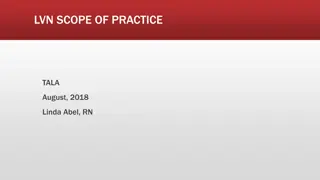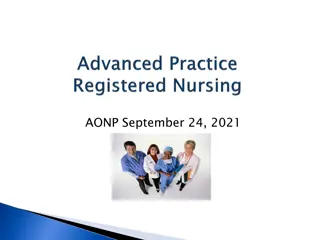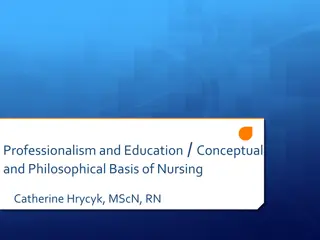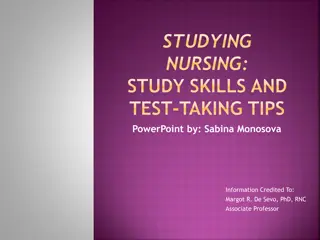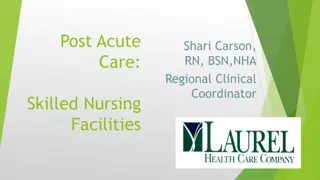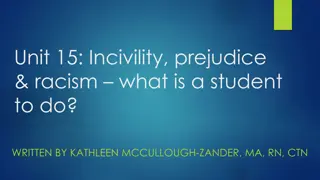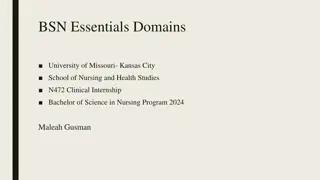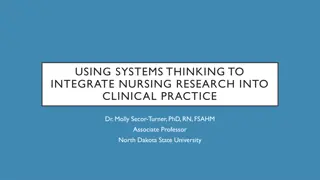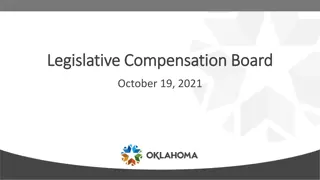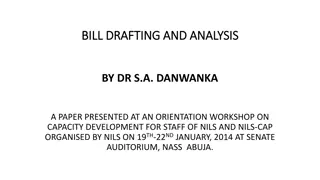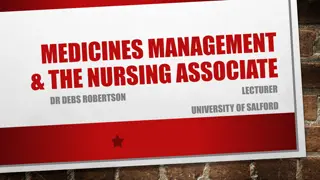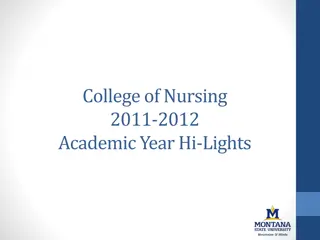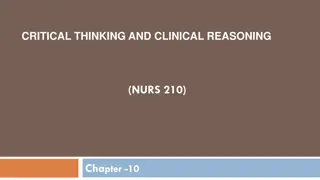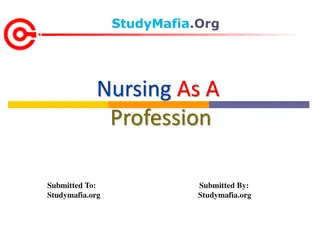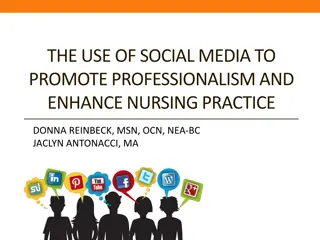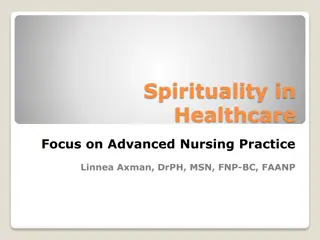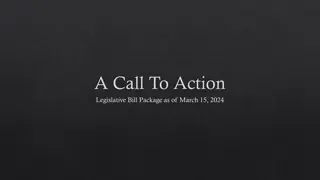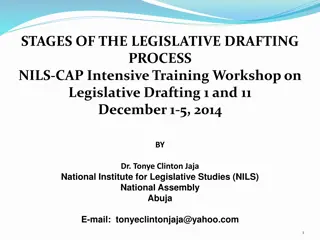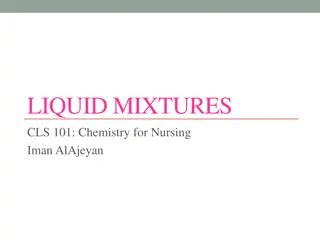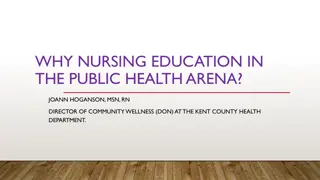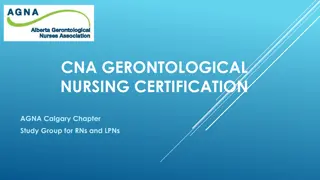Understanding Legislative Issues in Nursing Practice
In today's healthcare system, nurses must navigate legal concepts and legislative processes. This includes the importance of legislation, civil and criminal law, legal limits of nursing encompassing standard of care and registration requirements governed by nursing council acts. Nurses need to be aware of the laws that protect their practice and define their scope of work.
Download Presentation

Please find below an Image/Link to download the presentation.
The content on the website is provided AS IS for your information and personal use only. It may not be sold, licensed, or shared on other websites without obtaining consent from the author. Download presentation by click this link. If you encounter any issues during the download, it is possible that the publisher has removed the file from their server.
E N D
Presentation Transcript
LEGISLATIVE ISSUES IN NURSING Mr. Ajay kumar sharma IInd year M.Sc.(N)
Introduction In today s complex world, with advancing technologies and an array of societal problems legal issues are important aspects of life. For nurses in practice within the current health care system, knowledge of basic legal concepts is vital.
Legislation Legislative bodies exist into enact legislation. The legislative process is a series of steps that a legislative body takes to evaluate, amend and vote on proposed legislation. Issues pointed of law or question of fact set forth in the pleading that is alleged by one party and denied by the other. To promote or sent out. In a lawsuit, a disputed
Law recognized or enforced by public and regular tribunals has the administration place. Civil law Civil law protects the right of individuals with in our society and encourages fair and equitable treatment among people. Criminal law Criminal law prevents harm to society and provides punishment for crones The law constituents body of principles
Legal limits of nursing Standard of care Registration Nursing council acts. Rules and regulations Standard operating procedure Student nurses
Standard of care Standard of care is defined as those acts that are permitted or prohibited form being performed by a prudent person wording within the parameters of experiences and conditions existing at that time. her training license,
Registration Nursing practice act are designed in order to protect the profession from encroachment by other groups and the public from those who practice nursing without a license. Registration is mandatory i.e. to practice nursing one must be licensed as nurse. Two of the present challenger for state board of nursing care increasing the scope of practice to include the expanding role of the nurse as clinical specialist.
Nursing council acts. Every state has law governing professions, with general provisions for all professionals and specific provision for each profession including nursing. In nursing, it is known as the state s nursing practice act. This law protects nursing practice, identifier the scope of practice, outlines professional and unprofessional conduct and creates a board of nursing authorize to make decisions about nursing.
Board of nursing activities includes the following. Approving school curriculum and program in nursing. Defining the scope of nursing and requirements for entry in to profession, such as licensure examination. Participating in disciplinary actions involving nurses. Identifying standards of care.
Rules and regulations Administrative rules and regulations are written within the scope of the authority granted by the legislative body of the respective state. Administrative agencies such as the board of nursing in each state, develop the rules and regulations that ensure the nursing practice act can be effectively implemented.
Standard operating procedure Standard operative procedure are written document that contain rules, policies, procedure, regulations and others for the patient care in various stipulated circumstances that are unique to the agency.
Student nurses If a client suffers harm as a direct result of the nursing students actions or from the lack of it, the liability for the in correction action is generally shared by the students, instructor, hospital an health care faculty.
Legal liability in nursing Invasion of privacy Illegal detention Torts Unintentional torts Intentional tort
Invasion of privacy The 4th amendment of the U.S. constitution protects every citizen s right to privacy. Disclosing confidential inappropriate third party or to unauthorized person such as a member of the press or the client s employer subjects the nurse to a possible slander change or liability. information to an
Illegal detention Prevention of movement or unjustified retention of a person without consent may be false imprisonment. Nurses must use restrains carefully and under the approval of a physician. A patient can not be forced to remain in the hospital against his will.
Torts A tort is a civil wring for which remedy is a common law action for damage that are liquidated and which is not exclusively the breach of contract or trust or a more equitable obligation. Act of omission In order to make a person liable for a tort, he must have done some act which he is not expected to must have failed to do his duties.
Unintentional torts 1. Negligence/malpractice It is an act of omission i.e. neglecting to a something that a reasonably prudent person would do or doing something that he would not do that complaints should contain the following 4 distinct elements A statement that the defendant has the duty to perform in a certain manner. An allegation that there was a breath of that duty. A statement of proximate cause proved by the court A demand for compensation the cover damages.
In a malpractice law suit, against a nurse, the following criteria must be established. The nurse owed a duty to the client. The nurse did not carry out that duty. The client was injured. The client s injury was the result of the nurse s failure carryout the duty properly.
Intentional tort 1. Assault and battery Assault is the threat touching another person without his or her consent. Battery is the actual carrying out of such a threat; battery is any intentional touching of another s body.
2. Defamation of character This includes false communication or communication resulting in injury to a person s reputation by means of print, by speech. The important issues in a claim of defamation of character are whether harm is done to the reputation of plan off. 3. Fraud It is the willful, purposeful and misrepresentative of self or an act that may cause harm to a person or property.
Legal concepts and the nurse client relationship Informed consent Death and dying Handling of bodies Autopsy Organ donation Short staffing Legal safe guards and nursing practice Living wills
Informed consent It is a person s agreement to allow something to happen based on full disclosure of facts needed to make intelligent decision. The primary issue is whether or not the patient is capable of understanding the medical condition, the risks of treatment or no treatment, the risks and benefits of the proposed intervention and any alternatives that may prone beneficial.
Key elements for informed consent The consent must be given by a mentally competent adult. Patient must understand exactly what he is consenting to. The consent should include risks to the procedure, alternative treatment available and prognosis if the treatment is refused. The consent is usually written to provide a record of the transaction. Consent to treatment a minor is usually by the parent or the legal guardian but now a days children who are at least seven years old are included in the decision making process.
Death and dying Ethical and legal questions are raised by the issue of euthanasia. Active euthanasia is defined as international homicide. Passive euthanasia, such removing breathing support or birth holding a blood transfusion from a terminally ill client, raises legal questions that are being death with by the court of law.
Handling of bodies Nurses are legally obligated to treat deceased person s remains with dignity and care wrongful handling could cause emotional harm to the survivors. Autopsy patient or a close family member. Consent for autopsy must be given by the
Organ donation Legally competent persons are free to donate their bodies or organs for medical use. The national organ transplantation act prohibits selling or purchasing of organs. Living wills Living wills are documents instructing physicians to with hold or withdraw life. Sustaining procedures of clients whose death is imminent.
Legal safe guards and nursing practice Nurses are obligated to follow physician s order unless they believe that the orders are not accurate or would be detrimental to the clients. A nurse carrying out an inaccurate order may be legally responsible for any harm suffered by the client. Short staffing The issue of inadequate staff may arise, sometimes. Legal problems may arise if there are enough nurses to provide competent care.
Legal issues in specialty practice area Perinatal nursing Pediatric nursing Medical surgical nursing Critical care unit Non discrimination Psychiatric nursing
Perinatal nursing Perinatal nursing involves care of women before, during and immediately after pregnancy as well as taking care of the new born. Many legal issues are involved in the care of a mother and her infant. Abortion is one of the most emotionally charged issues confronting prenatal nurses. In most states and provisions laws concerning abortion included conscience clauses. The clauses allow nurses, physicians and the institutions to refuse to assist abortions without fear of reprisal if the abortion is against their ethical, principles. provision known as moral or religious
Pediatric nursing Every state and province with child abuse legislation requires that suspected child abuse or neglected may liable for civil or criminal legal action. Pediatric nurses are responsible for protecting of child from accidentally harming themselves. All poisonous substances and sharp objects should be kept out of under constant surveillance to minimize opportunities for accidental harm.
Medical surgical nursing Disoriented adult may require some form of restraint to prevent accidental self injury standards of care, laws and regulation about the use of restraints and supervision apply to nursing practice with medical, surgical and other clients. Side rails are available on most hospital beds for adult clients.
Critical care unit Critical care unit nurses require additional training and ongoing in service education to provide them with advancement in methods of patient care legal problems for critical care nurses are associated with the use of electronic monitoring devices. information about
Psychiatric nursing Clients with mental illness are hospitalizing for rehabilitation so that may return society as useful and healthy citizen s, if the nurses fails to prevent the clients from slipping off from the treatment, the nurses and the employer would be held liable for any injuries that clients sustains or inflict as a result of the employment.
Non discrimination Discrimination against those who are HIV challenged is prohibited by law. in 1990 congress passed legislation that, among other provision, extend civil right protection to persons with AIDS.
Laws applicable to nursing practice The right to refuse to treat a patient except in an emergency situation. The right to sue for fees. The right to add little or descriptions to the name. Unregistered practitioners are not allowed to hold appointments in public or local hospitals. Fundamental duties.
Fundamental duties To exercise a reasonable degree of skill and knowledge in treating patients. A practitioner must given personnel attention to her/his cases and answer calls with reasonable. Children must be protected from harming themselves. The Indian penal code states that poisonous drug be kept in separate containers properly labeled marked.
Common legal hazards in nursing Many hazards can be found in the environment of the institution such as slippery floor, faculty, equipment and electric writing absence of bedside rails when required, presence of inflammable substance, inadequate protection from stray animals inadequate lighting etc.
Summary Conclusion





